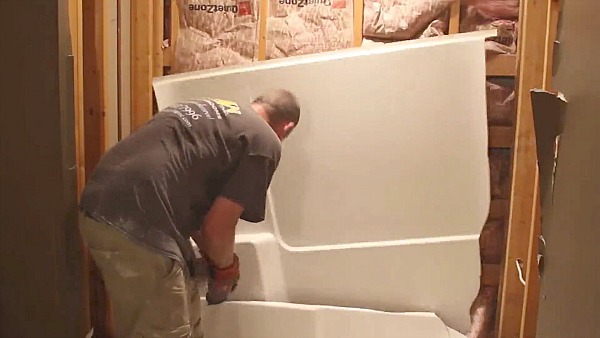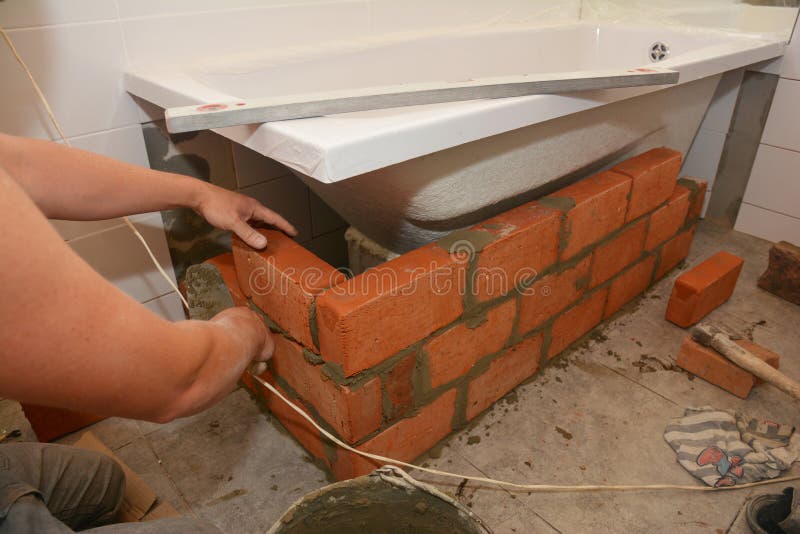How to Install a Bath Tub (Step By Step).
How to Install a Bath Tub (Step By Step).
Blog Article
Presented here below you can get a bunch of quality answers pertaining to Tools You Need to Install a New Bathtub .

Installing a tub isn't specifically brain surgery, but it does need strong plumbing, woodworking, and in some cases, tiling abilities. Changing an old bath tub with a new one is also a moderately tough task. If the old tub is readily available, the job can relocate speedily; if you have to open a wall to eliminate the old bathtub and also place the brand-new bathtub, the task is much harder. In either situation, the job is within a house handyman's abilities, although you will certainly require an assistant to vacate the old bathtub and set in the new one. Ensure you have qualified yourself for the task as well as fit trying it. Instead of employing a service provider to take control of a halfway-completed task, it is far better to take into consideration utilizing one prior to you start. Possibilities are you might need an expert plumber to make tube connections.
This short article will help you install a new bathtub in your bathroom if you have actually currently acquired a brand-new bathtub as well as don't need to change the arrangement of your previous water supply pipes.
Your devices and also product checklist ought to comprise the following:
Removing Old Touches
If you require to replace old taps with brand-new ones as a part of your installment, after that the first thing you ought to do is disconnect the water supply. After doing so, activate the faucets to drain any water continuing to be in the system. The procedure of eliminating the existing taps can be quite bothersome because of the restricted access that is usually the situation.
Utilize a basin wrench (crowsfoot spanner) or a faucet tool to undo the nut that attaches the supply pipes to the taps. Have a towel prepared for the remaining water that will certainly come from the pipelines. Once the supply pipelines have been eliminated, use the exact same tool to loosen up the nut that holds the faucets onto the bath/basin. You will require to stop the solitary taps from transforming during this procedure. Once the taps have actually been removed, the holes in the bath/basin will need to be cleaned of any kind of old sealing substance.
Prior to proceeding to fit the brand-new taps, contrast the pipe connections on the old faucets to the new faucets. If the old faucets are longer than the new faucets, after that a shank adapter is required for the brand-new taps to fit.
Suitable New Taps
If the tails of the brand-new taps are plastic, after that you will need a plastic adapter to avoid damages to the thread. One end of the adapter fits on the plastic tail of the tap and also the other end gives a connection to the current supply pipes.
If you require to fit a monobloc, then you will certainly call for lowering couplers, which connects the 10mm pipeline of the monobloc to the standard 15mm supply pipeline.
Next off, position the faucet in the mounting hole in the bath/basin making certain that the washers remain in place between the faucet and the sink. Secure the faucet in position with the producer supplied backnut. Once the tap is firmly in place, the supply pipes can be attached to the tails of the faucets. The taps can either be linked by utilizing corrugated copper piping or with normal tap adapters. The former type must be attached to the tap ends initially, tightening up only by hand. The supply pipes can later on be linked to the various other end. Tighten up both ends with a spanner after both ends have been attached.
Installing the Tub
Using the two wood boards under its feet, place the tub in the required setting. The wooden boards are practical in equally spreading the weight of the tub over the location of the boards as opposed to concentrating all the weight onto four small points.
The following objective is to make certain that the bathtub is leveled all round. This can be achieved by inspecting the level and also readjusting the feet on the bathtub until the spirit level checks out level.
To set up faucets, fit all-time low of the outermost adaptable tap connector to the suitable supply pipe by making a compression join; then do the exact same for the various other faucet.
Activate the water and also examine all joints and new pipework for leaks and tighten them if necessary. Fill the bathtub and also check the overflow outlet and the normal outlet for leaks.
Finally, fix the bath paneling as described in the manufacturer's instruction manual. Tiling and also securing around the bath tub needs to wait till the bath tub has actually been utilized a minimum of once as this will settle it right into its last placement.
Planning for the Setup
Firstly, the supporting frame provided with the bathroom must be fitted (if needed) according to the producer's instructions. Next off, fit the faucets or mixer to the tub. When fitting the tap block, it is important to make sure that if the faucet includes a plastic washer, it is fitted between the bathroom as well as the taps. On a plastic bath, it is additionally reasonable to fit a supporting plate under the taps device to avoid stress on the bathtub.
Fit the adaptable faucet connectors to the bottom of the two faucets utilizing 2 nuts and olives (occasionally provided with the tub). Fit the plug-hole electrical outlet by smearing mastic filler round the sink electrical outlet hole, and afterwards pass the electrical outlet with the hole in the bath. Make use of the nut supplied by the manufacturer to fit the plug-hole. Check out the plug-hole outlet for an inlet on the side for the overflow pipe.
Next off, fit the end of the adaptable overflow pipeline to the overflow outlet. Afterwards, screw the pipe to the overflow face which need to be fitted inside the bathroom. Make sure you make use of all of the provided washers.
Connect the catch to the bottom of the waste outlet on the bath tub by winding the thread of the waste electrical outlet with silicone mastic or PTFE tape, as well as screw on the catch to the outlet. Attach the bottom of the overflow tube in a comparable manner.The bath should currently be ready to be suited its last setting.
Tiling Around the Bathtub
In the location where the bathroom satisfies the tile, it is needed to secure the joins with a silicone rubber caulking. This is necessary as the fitting can move sufficient to crack a stiff seal, causing the water to pass through the wall in between the bath and the tiling, causing complications with wetness and feasible leaks to the ceiling below.
You can choose from a range of coloured sealers to blend in your fixtures and also fittings. They are offered in tubes and also cartridges, and can securing gaps as much as a size of 3mm (1/8 inch). If you have a larger gap to fill up, you can load it with twists of soaked paper or soft rope. Remember to always fill up the bath tub with water before sealing, to permit the activity experienced when the tub is in usage. The sealer can fracture fairly early if you do not take into consideration this activity before sealing.
Additionally, ceramic coving or quadrant floor tiles can be made use of to border the bath or shower tray. Plastic strips of coving, which are easy to use and cut to dimension, are additionally easily available on the market. It is a good idea to fit the floor tiles making use of water-resistant or waterproof sticky as well as cement.
Bathtub Installation
How Important Is A Bathtub To Your Home?
High-quality baths, showers, and other bathroom updates are necessary when considering a smart investment in your home. It’s a room that you go to every day and one that is constantly being used by guests.The bathroom is one of the top trafficked rooms in a home and also one of the most valuable in terms of home resale.
Install Piping Before Tub
You will be using your existing drain and waste vent system, but pipes required include the hot and cold water supply lines and a pipe leading to a shower head. A mixing valve and shower head are also needed. Air chambers may be required.
Position the Tub
Lower the tub into place so that the continuous flange fits against the wall studs and rests on 1’x4' or 2’x4' supports. Anchor the tub to the enclosure with nails or screws inserted through the flanges into the studs.
NOTE: Remember, bathtubs and shower stalls may require support framing. A bathtub filled with water is extremely heavy, so check building codes and framing support before installing the tub.
Assemble Drain Connections
Assemble the bathtub drain connections by connecting the tub overflow with the tub drain above the trap, not beyond it. The trap will have a compression fitting that screws over the arm of the overflow assembly.
Place a Pipe For the Shower Head
First, locate a brass female threaded winged fitting and attach it to a framing support via a screw or a nail. Then run a pipe up the wall for the shower head. Sweat or solder the other side of the brass fitting to the top of the pipe.
Attaching Hot and Cold Water Lines
Attach your water lines for both hot and cold by sweating these directly into the hot and cold ports of the mixing valve. The mixing valve will be how water enters the tub’s system, not by the pipes themselves.
Install the Spout
Extend a piece of 1/2 inch pipe, or whichever length is specified in the manufacturer’s instructions, for the tub spout. Sweat on a male threaded fitting at the end of the pipe or use a brass nipple of the proper length and a 1/2 inch cap.
NOTE: At this point you should have your rough-in plumbing work inspected before proceeding further.
Check For Leaks
Restore the water pressure and check the drain connection and the supply pipes for any sign of leaking.
estore the Bathroom Wall
Replace the wall with moisture-resistant drywall as a base for your wall covering. Seal the joints between the wall and your new tub with silicone caulk as protection against water seepage.
https://www.berkeys.com/2016/12/02/bathtub-installation-dallas/

I have been very focused on Installing A Bathtub and I am praying you enjoyed our article. Sharing is good. Who knows, you may just be helping someone out. We truly appreciate reading our article about How to Install a Bathtub.
Schedule Appointment Now Report this page